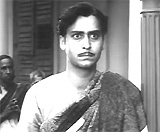
|
Devi (1960, India) (aka The Goddess)
In Satyajit Ray's drama with stunning black and white
cinematography, set in mid-19th century rural Bengal - a critique
of religious fanaticism, superstition, and obsessive and ignorantly-blind,
devoted beliefs in miracles and false idols:
- the opening symbolic montage of a morphing stone
statue head (under the title credits and after) - first with only
blank contours, and then ornamented and bejewelled, transformed
and overly-decorated; the face represented the Hindu diety of Kali
after a slow camera zoom-out - the feared ten-armed 'mother goddess'
of creation and destruction (and the consort of Lord Shiva), bedecked
and worshipped during the annual religious festival of Durga Puja
by frenzied, celebrating subjects as they paraded the statue in
a procession towards a river (with fireworks) - where the inexpressive
statue was submerged in the water and floated back to its source
in the Himalayas
- the character of beautiful and shy teenaged Doyamoyee
or "Doya" (Sharmila Tagore), who was married to intellectual
husband Umaprasad or "Uma" (Soumitra Chatterjee), who was
planning to study at the university in Calcutta before raising a
family with his young wife; after their marriage, "Doya" moved
in with his family
- "Doya" cared for
her aging, rich land-owner (zaminder), widowed father-in-law Kalikinkar
Roy (Chhabi Biswas) (who called her "mother"), a follower
of Devi (Durga)
- the scene of Kalikinkar's feverish, visionary divine
dream - he imagined the matching third-eye on the statue of the goddess
of Kali merging and superimposed onto his daughter-in-law Doya's
face and forehead (and her decorative bindi), symbolizing divine
insight; he awoke with absolute certainty that Doya was blessed -
as an incarnation of the mother goddess deity Kali
- Kalikinkar's manipulative conviction and insistence
that everyone worship Doya, and that she had spiritual powers; at
first reluctant, the naive and trusting Doya felt dutiful, submissive
and compelled to obey his wishes - and eventually came to believe
in her own transformation as a healing goddess (after she miraculously
cured one man's dying young grandson); she was placed on a shrine-platform
to sit confined and immobile for hours to receive supplicants, homage
and prayers from priests and the sickly
- the striking scene when Uma returned home from his
exams, and became visibly upset by the sight of his wife when he
came upon her with throngs around her - she had been transformed
into an object of worship with worshippers standing in line to see
her (with subtle movements, she noticed his arrival wth a momentary
look up at him, a slight movement of her head horizontally (signifying
no) with a tear in her right eye, and a half-smile followed by a
flash of fear in her eyes, and then a look down); as he looked away
and departed, her eyes followed him
Husband "Uma" Upset at Sight of Wife "Doya" as
an
Object of Worship as Healing Goddess Kali
|

|

|

|
- the tragic conclusion when she failed to cure her
young nephew Khoka (Arpan Chowdhury), and she went insane

|

|
|
Unable to Cure Nephew
|
Doya's Flight
|
- in the final image - shot as an apparition, she
fled across a meadow of flowers and disappeared into a mist near
the river
|

Stone Statue Head

Morphed into Hindu god Kali

The 10-Armed Mother Goddess

Teenaged "Doya" with Husband "Uma"


Kalikinkar's Fever Dream about Doya Being an Incarnation of Kali

Kalikinkar

|









